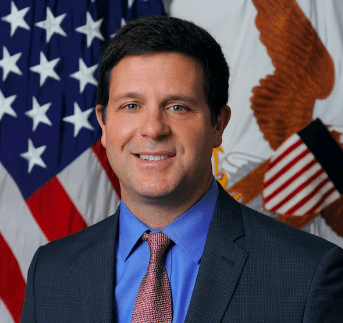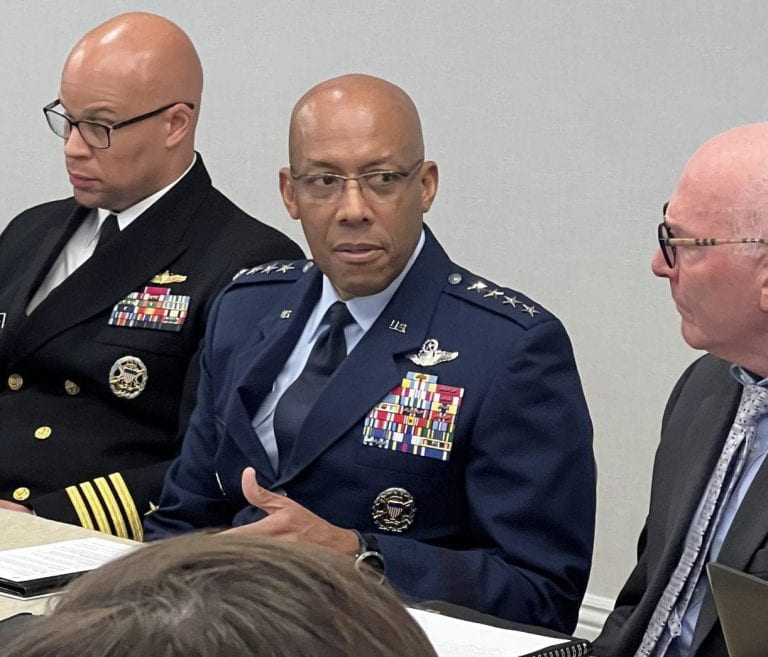Marine Corps Commandant Gen. Eric Smith said that plans to move 4,000 Marines from Okinawa to Guam will put those forces far from where they are needed.
JEFF SCHOGOL
Marine Corps Commandant Gen. Eric Smith cautioned on Wednesday that ongoing efforts to relocate Marines from Okinawa to Guam will move those forces away from where they are most needed.
“Frankly, Guam puts us going the wrong way,” Smith told reporters at a Defense Writers Group Breakfast in Washington, D.C. “Guam puts us on the other side of the International Date Line, but it puts us a long way from the crisis theater, from the priority theater.”
About 19,000 Marines are currently stationed in Okinawa. The United States and Japan agreed in 2012 to move about 9,000 Marines from Okinawa to Guam and other locations in the Pacific, including Hawaii. About 4,000 Marines are expected to be stationed on Guam, where Camp Biaz will serve as their primary installation.
Although the Marine Corps is committed to drawing down to about 10,000 Marines on Okinawa, the move to Guam is a “challenge,” Smith told reporters on Wednesday.
For example, the Army also expects to deploy forces to Guam, and that would limit the space available for the Marines, Smith said. Apra Harbor, where aircraft carriers and other Navy ships can dock, is also undergoing infrastructure updates. In April 2023, a $106.9 million contract was awarded for an embarkation and debarkation facility for Marines.
“So, I’m not sure that is in the best strategic interests of America, to be honest with you,” Smith told reporters on Wednesday. “But it is a treaty obligation we have with Japan, which we’re going to comply with unless, and until, it changes.”
Roughly 100 logistics support Marines with III Marine Expeditionary Force began moving from Okinawa to Guam in December.
The Marine Corps supports the 2012 agreement between Japan and the United States and the planned relocation of forces to Guam or Hawaii, a spokesperson for the service told Task & Purpose on Wednesday.
“The Marine Corps will continue to explore options for the best location for the future force in the region,” they said. “The realignment of Japan-based Marines is the result of nearly 20 years of bilateral policy negotiation reflected in multiple international agreements and arrangements. This laydown honors an international agreement with the [Japanese government].”
Okinawa is part of the “first island chain,” which refers to a chain of islands in the Pacific that includes Japan, Taiwan, the Philippines, and Indonesia, which would be the front line in a war with China. U.S. military leaders have speculated that China could attempt to invade Taiwan by 2027. Although the Taiwan Relations Act of 1979 is vague about how the United States would respond to a Chinese invasion of Taiwan, President Joe Biden has repeatedly vowed to defend the island nation.
Pete Hegseth, President-elect Donald Trump’s nominee for defense secretary, testified during his confirmation on Tuesday that the incoming administration will make deterring China a top priority.
“We’re going to start by ensuring the institution understands that as far as threats abroad, the [Chinese Communist Party] is front and center — also, obviously defending our homeland as well,” Hegseth said.
China’s aggressive claims that it controls waters administered by other countries in the Western Pacific and the Defense Department’s focus on the Indo-Pacific region provide an argument to possibly consider relooking at the agreement to move Marines from Okinawa to Guam, Smith said.
“That’s obviously a domestic issue for the Japanese government to decide,” Smith said. “But what I do know is every time you give China a foot, they take a mile. They only understand one thing, which is a credible deterrent force. And that credible deterrent force has to be present to win, which to me means being in the first island chain.”











